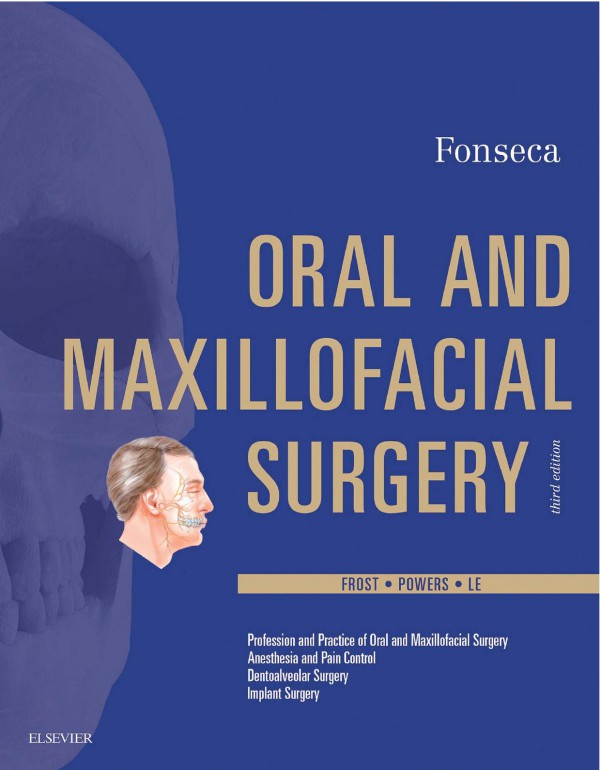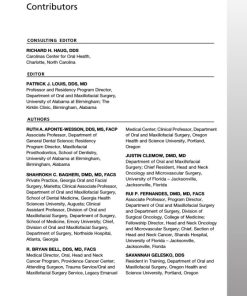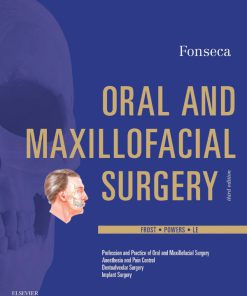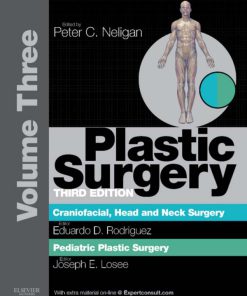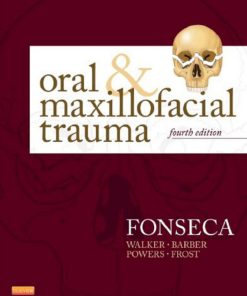Oral and Maxillofacial Surgery E Book 3 Volume Set 3rd Edition by Raymond Fonseca 0323414990 9780323414999
$50.00 Original price was: $50.00.$25.00Current price is: $25.00.
Authors:Raymond J. Fonseca , Tags:Oral and Maxillofacial Surgery; 796pp. 978-0-323-41499-9 , Author sort:Fonseca, Raymond J. , Published:Published:Jun 2017 , Comments:Comments:Oral and Maxillofacial Surgery, 796pp. 978-0-323-41499-9
Oral and Maxillofacial Surgery E Book 3 Volume Set 3rd Edition by Raymond Fonseca – Ebook PDF Instant Download/Delivery. 0323414990, 9780323414999
Full download Oral and Maxillofacial Surgery E Book 3 Volume Set 3rd Edition after payment

Product details:
ISBN 10: 0323414990
ISBN 13: 9780323414999
Author: Raymond J. Fonseca
This trusted, three-volume resource covers the full scope of oral and maxillofacial surgery with up-to-date, evidence-based coverage of surgical procedures performed today.
Oral and Maxillofacial Surgery E Book 3 Volume Set 3rd Table of contents:
Vol 1 Section 1: Profession and Practice of Oral and Maxillofacial Surgery
Chapter 1: Professionalism and Ethics
What is the Definition of “Professionalism”?
Evaluation of the Student (Resident) and Adherence to Professional Behavior
Causes of Unprofessional Behavior
The Link between Disciplinary Actions and Prior Behavior in Professional School
How are Ethics and Professionalism Linked?
Ethical Dilemmas
The Politics of Town and Gown
Chapter 2: The Philosophical Basis of a Successful Surgical Practice
The Definition of Success
Interpersonal Relationships for Success
Summation
Chapter 3: Oral and Maxillofacial Surgery Career Alternatives to Private Practice
Introduction
United States Army Oral and Maxillofacial Surgery Careers
United States Navy Oral and Maxillofacial Surgery Careers
United States Air Force Oral and Maxillofacial Surgery Careers
United States Public Health Service Oral and Maxillofacial Surgery Careers
Veterans Affairs Oral and Maxillofacial Surgery Careers
Academic Oral and Maxillofacial Surgery Careers
Surgeon-Scientist Oral and Maxillofacial Surgery Careers
Dental Support Organizations
Conclusion
Chapter 4: OMS Practice Transition: Decisions for the New Surgeon and the Established Surgeon
Introduction
Entrance Planning: Considerations for the New Graduate Surgeon
Exit Planning: Strategic Considerations for the Established Senior Surgeon
Chapter 5: Performing Oral Surgery from the Sitting Position
Introduction
Administering General Anesthesia
Additional Suggestions
Summary
Chapter 6: Business Management of the Oral and Maxillofacial Surgery Practice
Introduction
Operational Issues
Risk Management
Managed Care Contracting
Practice Advisors
Organizational Structures
Financial Management
Summary
Chapter 7: Risk Management in Oral and Maxillofacial Surgery
What Is Risk Management?
Why Risk Management: Preventing and Mitigating Risk
Why Risk Management: Managing Risk
Regulatory Awareness
Concluding Thoughts
Chapter 8: Coding, Insurance, and Third-Party Payers
General Overview
Insurance Contracts
Code Sets
Medicare
Trauma
Pathology
E&M Codes
Affordable Care Act
Chapter 9: Accreditation of Outpatient Surgery Facilities
What Does It Mean to “Be Accredited”?
Benefits of Accreditation
Chapter 10: Marketing the Oral and Maxillofacial Surgery Practice
Social Media: The Game Changer
What’s in a Name?
Academic Marketing
Learning from Big Business
Marketing Your Practice
What Is Your Vision?
Hiring and Firing
Professional Consultation
Employee Relations
Initiating a Marketing Plan
Summary
Chapter 11: Challenges of Retirement
Introduction
Change and Its Challenges
The Importance of Balance
Leaving a Legacy
Behavioral Health
Piddling, Potholes, and Pearls
Chapter 12: Boundary Violations and Physical and Mental Impairments
Introduction
Maintaining Proper Boundaries
Avoiding Disruptive Behavior
Conclusion
Vol 1 Section 2: Anesthesia and Pain Control
Chapter 13: Preoperative Evaluation
Introduction
History and Physical Examination
Conducting the Preoperative Evaluation
Conclusions
Chapter 14: Monitoring for the Oral and Maxillofacial Surgery Patient
Introduction
Definitions
History and Evolution of Monitoring Guidelines
Chapter 15: Local Anesthetics
History of Local Anesthetics
Chemistry of Local Anesthetics
Structure and General Properties of Local Anesthetics
Efficacy and Duration of Action of Local Anesthetics
Use of Vasoconstrictors
Complications of Local Anesthetics
Systemic Complications from Local Anesthesia
Local Anesthetic Comparisons
Special Considerations
New Developments and the Future of Local Anesthetics
Chapter 16: Pharmacology of Drugs in Ambulatory Anesthesia
Introduction
Benzodiazepines
Opiates and Opioids
Intravenous Sedative-Hypnotics
Ketamine
Inhalation Anesthetics
Conclusion
Chapter 17: Anesthetic Concepts and Techniques
Introduction
Levels of Sedation
Goals of Sedation
Concept of Rescue
Airway Assessment
Laryngeal Mask Airway
Smoking
Preoperative Fasting
Fluid Administration
Anesthetic Techniques in Office-Based Anesthesia
Patient Positioning
Postoperative Recovery and Discharge
Know When to Stop
Chapter 18: Concepts in the Management of Acute Postoperative Pain
Introduction
Review of Neuroanatomy and Pathophysiology of Pain
Opioid Analgesics
Non-opioid Analgesia
Local Anesthetics
Adjunctive Medications
Acute Pain Management Strategies
Conclusion
Chapter 19: Pediatric Pharmacosedation and General Anesthesia
Introduction
Pediatric Anatomic, Physiologic, and Pharmacologic Differences
Preanesthetic Assessment
Monitors
Equipment and Room Preparations
Pharmacosedation and General Anesthesia
Perioperative Complications
Recovery and Discharge
Summary
Vol 1 Section 3: Dentoalveolar Surgery
Chapter 20: Pediatric Dentoalveolar Surgery
Introduction
The Pediatric Demographic
Pediatric Dental Development
Pediatric Anatomy
Physiology
Hard Tissue Surgery
Treatment
Dental Implants in Children
Soft Tissue Procedures
Pediatric Challenges
Chapter 21: Basic and Complex Exodontia and Surgical Management of Impacted Teeth
Introduction
Removal of Erupted Teeth
Impacted Teeth
Chapter 22: Complications of Dentoalveolar Surgery
Introduction
Complications during Exodontia
Complications after Exodontia
Complications that Can Occur during or after Exodontia
Chapter 23: Skeletally Based Implant Assisted Orthodontics
Introduction
History and Literature Review
Orthodontic Concepts for Surgeons
Types of Orthodontic Implant Anchors
Clinical Application and Case Presentation
Surgical Techniques and Materials
Prevention of Complications
Conclusions
Chapter 24: Lasers in Oral Surgery
Laser Physics
Common Laser Wavelengths
Benefits of Laser Surgery
Disadvantages of Laser Surgery
Laser Safety
Intraoral Laser Soft Tissue Surgery
Low-Level Laser Therapy
Lasers and Wound Healing
Effects of Lasers on Postoperative Pain and Swelling
Laser Use in Dental Implant Surgery
Laser-Assisted Temporomandibular Joint Surgery
Laser-Assisted Facial Skin and Cosmetic Surgery
Laser Treatment of Vascular Lesions
Laser Treatment of Pigmented Lesions and Tattoos
Laser Hair Reduction/Removal
Laser Use in General Dentistry
Laser Use in Craniofacial Surgery
Chapter 25: Trigeminal Nerve Injuries
Causes, Classification, and Injury Responses
Clinical Measurement and Diagnoses
Nonsurgical Treatments
Surgical Management of Nerve Injuries
Clinical Applications
Outcomes and Conclusions
Vol 1 Section 4: Implant Surgery
Chapter 26: Esthetic Implant Dentistry: Diagnosis and Treatment Planning
Introduction
Patient Selection and Smile Line
Root Position of the Adjacent Teeth
Biotype of Periodontium and Tooth Shape
Summary
Chapter 27: Immediate Implants
Introduction
Esthetic Complications
Preoperative Workup
Surgical and Restorative Principles for Immediate Implant Placement
Immediate Molar Implants
Multiple Immediate Implants and Adjacent Implants in the Esthetic Zone
Summary
Chapter 28: Bone Grafting Techniques and Materials
Introduction
Bone Biology and Healing
Autogenous Grafts
Allografts
Xenografts
Alloplasts
Preoperative Evaluation
Factors Contributing to Suboptimal Bone Graft Healing
Chapter 29: Bone Graft Biology and Histology
Introduction
Classification of Bone Substitute/Augmentation Materials
Classification of Bone Growth Enhancing Materials Related to the Influence on Bone Growth
Histologic Examples of Different Bone Augmentation Techniques
Factors Involved with Poor Results
Evaluation of Bone Augmentation Procedures
Advantages and Limitations of Human Bone Core Specimens
Chapter 30: Autogenous Bone Grafting for Dental Implants
Introduction
Bone Biology
Preoperative Evaluation
Patient Preparation
Bone Graft Donor Sites
Graft Recipient Site
Postoperative Care
Block Bone Grafts
Guided Bone Regeneration
Sinus Bone Grafting
Titanium Mesh Grafts
Graft Resorption
Implant Placement in Grafted Sites
Chapter 31: Guided Tissue Regeneration in Implant Dentistry
Introduction
Defect Configuration
Principles of GBR
Membrane Selection
Space Maintenance
Applications for Guided Bone Regeneration
Postoperative Considerations
Summary
Chapter 32: Contemporary Sinus-Lift Subantral Surgery and Graft
Introduction
Biologic and Anatomic Considerations
Vascular Supply
Pretreatment Considerations
Preoperative Evaluation
Techniques
Postoperative
Chapter 33: Osteoperiosteal Flaps and Distraction Osteogenesis
Alveolar Osteotomy Space Maintenance Using Osteoperiosteal Flaps
Three-Dimensional Alveolar Distraction for Implant Placement
Chapter 34: Peri-implant Soft Tissue Augmentation
Peri-implant Soft Tissue Interface
Anatomy of Peri-implant Mucosa
Significance of Peri-implant Mucosa
Peri-implant Soft Tissue Augmentation
Application of Graft Substitutes For Peri-implant Soft Tissue Augmentation
Vestibular Incision Subperiosteal Tunnel Access
Conclusions
Chapter 35: Zygomatic Implant: A Graftless Approach for Treatment of the Edentulous Maxilla
Historical Perspective
Patient Selection
Radiographic Evaluation
Os Zygomaticum: Regional Anatomy
Preoperative Considerations
Surgical Options
Surgical Protocol
Prosthetic Conversion Technique
Postoperative Care
Surgical Complications
Final Prosthesis Fabrication
Summary
Chapter 36: Fixed Restoration of the Edentulous Maxilla
Introduction
Diagnosis
Extraoral Examination
Summary
Chapter 37: Mandibular Immediate Implant Loading with the Complete Arch Provisional Prostheses
Introduction
Literature Review
Mandibular Complete Denture Conversion to a Provisional Implant-Supported, Screw-Retained Fixed Prosthesis for Immediate Loading
Chapter 38: Contemporary Restorative Options for the Single Implant
Introduction
Restorative Options
Screw Retention versus Cement Retention
Decision Making
Discussion
Conclusion
Chapter 39: Implant Overdentures
Introduction
General Guidelines in Treatment Planning
Consensus and Controversy Associated with Mandibular Implant Overdentures
Success, Failure, and Complications Data
Design Principles
Synopsis of Design Guidelines8
Clinical Procedures for Two-implant Overdenture and Three- or Four-implant Overdenture
Chapter 40: Implants in Acquired and Congenital Defects
Introduction
Acquired Defects
Congenital Defects
Summary
Chapter 41: Three-Dimensional Imaging and Digital Workflow Protocols for Dental Implants and Bone Grafting
Introduction
Case Examples: Anterior Maxillary Deficiency
Biomedical Models/Stereolithography: Digital Workflow
Surgical Guide Fabrication: Bone-Borne Template Maxilla
Innovative New Protocols: Donor Sites, Sinus Grafting, and Reconstruction Surgery
Conclusion
Chapter 42: Peri-implant Disease and Restorative Aspects of Dental Implants
Introduction to the Association of Residual Excess Cement and Peri-implant Disease
Cemented Restorations and Issues Related Specifically to Dental Implants
Biology of the Soft Tissue Attachment to a Dental Implant
Implant Depth and Cement Margin Site
Conclusion
Chapter 43: Peri-implant Disease
Introduction
Prevention and Maintenance
Treatment and Outcomes
Future Directions
Conclusions
Vol 2 Section 1: Trauma
Chapter 44: Initial and Postoperative Management of the Craniomaxillofacial Trauma Patient
Introduction
Initial Assessment
Mechanism of Injury
Considerations Regarding the Medical History
Clinical Examination
Planning for Definitive Care
Preventative Measures to Optimize Patient Care in the Preoperative Setting
Postoperative Management
Chapter 45: Airway and Anesthetic Management for the Traumatized Patient
The Importance of the Airway in Maxillofacial Trauma
Anesthetic Strategies
Chapter 46: Imaging in Maxillofacial Trauma
Introduction
Image Acquisition
Image Interpretation
Facial Fracture Patterns
Frontal Bone Fractures
Orbital Fractures
Zygomatic Fractures
Nasal/Naso-orbito-ethmoid Fractures
Maxillary Fractures
Mandibular Fractures
Pediatric Facial Fractures
Craniomaxillofacial Fractures with Associated Cervical Spine or Intracranial Injury
Summary
Chapter 47: Soft Tissue Injuries of the Face, Head, and Trunk
Initial Evaluation
Suture Technique and Suture Materials
Principles of Wound Closure
Management of Special Anatomic Units
Postoperative Care
Animal and Human Bites
Facial Burns
Chapter 48: Diagnosis and Management of Trigeminal and Facial Nerve Injuries
Introduction
Classification of Nerve Injuries
Trigeminal Nerve Anatomy
Trigeminal Nerve Imaging
Mechanisms of Injury to the Trigeminal Nerve
Clinical Neurosensory Testing
Indications for Microneurosurgery
Microneurosurgery for Trigeminal Nerve Injuries
Outcomes of Trigeminal Nerve Injury and Surgical Intervention
Facial Nerve Anatomy
Facial Nerve Imaging
Classification of Facial Nerve Injury
Mechanisms of Injury to the Facial Nerve
Clinical Evaluation of Facial Nerve Injury
Treatment of Traumatic Extratemporal Facial Nerve Injuries
Outcomes of Facial Nerve Injury and Surgical Intervention
Chapter 49: Diagnosis and Management of Dentoalveolar Injuries
Introduction
Evaluation of the Dentoalveolar Injury Patient
Physical Examination
Radiographic Examination
Classification of Dentoalveolar Fractures
Treatment of Dentoalveolar Injuries
Treatment of Specific Types of Injuries to the Hard Dental Tissues and Pulp
Treatment of Injuries to the Periodontal Tissues
Treatment of Injuries to the Primary Teeth
Treatment of Injuries (Fractures) to the Supporting Bone
Treatment of Gingival and Mucosal Injuries
Prognosis of Dentoalveolar Trauma
Prevention of Traumatic Dental Injury
Conclusions
Chapter 50: Diagnosis and Management of Mandible Fractures
Introduction
History of Mandible Fractures
Pathogenesis
Anatomy
Patient Assessment
Treatment of Mandible Fractures
Controversial Topics in Mandible Fracture Repair
Complications
Conclusion
Chapter 51: Nasal Fractures
Introduction
Applied Anatomy and Pathogenesis
Diagnosis and Evaluation of Nasal Fractures
Classification of Nasal Fractures
Treatment of Nasal Fractures
Nasal Fractures in Children
Complications of Nasal Fractures
Chapter 52: Management of Zygomatic Fractures
Introduction
Anatomy
History and Physical Examination
Indications for Radiographs and Surgery
Treatment
Surgical Approaches for Fractures of the Zygomatic Complex
Approaches to the Zygomaticofrontal Region
Approaches to the Infraorbital Rim and the Orbital Floor
Approaches to the Arch and the Zygomaticotemporal Suture
Fixation
The Zygomatic Arch
Surgical Approaches to Isolated Zygomatic Arch Fractures
Complications of Zygoma Injuries
Three-Dimensional Computerized Navigation
Chapter 53: Diagnosis and Management of Midface Fractures
Introduction
Midface Anatomy
Classification of Midface Fractures
Le Fort Fractures
Naso-Orbital-Ethmoid Fractures
Complications
Endoscopic Repair of Midface Fractures
Summary and Future Advancements
Chapter 54: Diagnosis and Management of Frontal Bone Injuries
Introduction
Surgical Anatomy
Clinical Evaluation
Radiologic Evaluation
Classification of Frontal Sinus Fractures
Surgical Management of Frontal Sinus Fractures
Endoscopic Repair
Postoperative Care
Complications
Chapter 55: Assessment and Management of the Injured Child
Epidemiology, Assessment, and Management of Pediatric Trauma
Wound Repair in Children after Injury
Chapter 56: Pediatric Craniomaxillofacial Trauma and Management
Introduction
Epidemiology and Trends
Assessment
Growth and Development
Fracture Management
Soft Tissue Injuries and Management
Avulsive Injuries
Special Regions
Bite Wounds
Summary
Chapter 57: Management of Avulsive Facial Injuries
Wound Assessment
Management
Reconstructive Concept
Complications
Chapter 58: Treatment of Maxillofacial Gunshot Wound Injuries
Classification of Bullets and Firearms
Components of Ballistic Missiles
Types of Firearms
Wound Ballistics
The Physics of Ballistics
Treatment of Maxillofacial Gunshot Wound Injuries
Primary Wound Treatment
General Guidelines for Wound Treatment
Case Varieties and Management
Repair of Facial Fractures and Low-velocity GSW Injuries
External Fixators for Maxillofacial GSW Injuries
Treatment Phases: Surgical Treatment of Mandible/Maxilla/Mid-face/Upper-face High-energy GSWs
Shotgun Injuries
Self-inflicted Gunshot Wounds
Intermediate Phase
Reconstructive Phase
Vol 2 Section 2: Surgical Pathology
Chapter 59: Oral and Maxillofacial Pathology: Available Diagnostic Techniques and Surgical Interactions
Introduction
Historical Perspective
Surgeon/Pathologist Interaction
Biopsy Techniques
Frozen Section
Aspiration Biopsy Techniques
Exfoliative Cytology
Special Histochemical Staining Techniques
Immunofluorescence Studies
Immunohistochemistry
Electron Microscopy
Flow Cytometry
Molecular Biology
Summary
Chapter 60: Cysts of the Oral and Maxillofacial Region
Definitions
General Surgical Considerations
Odontogenic Cysts
Developmental
Non-odontogenic Cysts
Chapter 61: Odontogenic Tumors: Surgical Pathology and Management
Introduction
Classifications
General Clinical, Diagnostic, and Management Considerations
Epithelial Odontogenic Tumors
Mesenchymal Odontogenic Tumors
Mixed (Epithelial/Mesenchymal) Odontogenic Tumors
Chapter 62: Benign Non-odontogenic Lesions of the Jaws
Lesions Containing Multinucleated Giant Cells
Fibro-osseous Lesions
Neurogenic Tumors
Other Tumors
Chapter 63: Salivary Gland Disease
Introduction
Salivary Gland Physiology
Imaging of the Salivary Glands
Cystic Conditions
Inflammatory/Reactive Conditions
Obstructive Disease
Tumors
Salivary Diseases Associated with Systemic Disease
Chapter 64: Diagnosis and Management of Medication-related Osteonecrosis of the Jaw
Introduction
Antiresorptive Agents: What Are They and How Do They Work?
Antiresorptive and Antiangiogenic Therapy in Clinical Practice
Medication-related Osteonecrosis of the Jaw
Treatment Guidelines
Future Research
Chapter 65: Langerhans Cell Histiocytosis
The Langerhans Cell
Chapter 66: Vascular Anomalies of the Oral and Maxillofacial Region
Infantile Hemangioma
Congenital Hemangioma
Vascular Malformations
Summary
Chapter 67: Vesiculobullous Diseases
Introduction
Herpes Simplex Virus Infections
Herpangina
Lichen Planus
Aphthous Stomatitis
Behçet Syndrome
Reactive Arthritis (Reiter Syndrome)
Pemphigoid
Pemphigus
Linear IgA Disease
Epidermolysis Bullosa
Erythema Multiforme
Chapter 68: Osteomyelitis and Osteoradionecrosis
Osteomyelitis
Osteoradionecrosis
Chapter 69: The Molecular Biology of Cancer
Introduction
Cancer Histology
Signal Pathways Are Altered by Cancer-Associated Molecular Changes
How Molecular Biology Can Affect Clinical Oncology: Toward the Rational Treatment of Cancer
Summary and Future Directions
Chapter 70: Sarcomas of the Jaws
Introduction
Classification
Etiology of Sarcomas
Diagnosis
Osteosarcoma
Chondrosarcoma
Malignant Fibrous Histiocytoma
Fibrosarcoma
Dermatofibrosarcoma Protuberans
Rhabdomyosarcoma
Leiomyosarcoma
Angiosarcoma
Hemangiopericytoma
Neurogenic Sarcoma
Liposarcoma
Synovial Sarcoma
Ewing Sarcoma
Alveolar Soft Part Sarcoma
Chapter 71: Squamous Cell Carcinoma of the Oral and Maxillofacial Region
Introduction
Anatomy
Epidemiology
Diagnosis and Pretreatment Evaluation
Staging
Nonsurgical Management
Surgical Management
Types of Neck Dissection
Follow-up
Summary
Chapter 72: Melanoma
Epidemiology
Incidence and Etiology
Diagnosis
Management of Regional Disease
Staging of Melanoma
Treatment
Oral Mucosal Malignant Melanoma
Summary
Chapter 73: Lymphoma
Introduction
Diagnosis
Hodgkin Lymphoma
Non-Hodgkin Lymphoma (NHL)
Angiocentric Lymphoma
Post-transplant Lymphoproliferative Disorder
Radiographic Evaluation
Treatment
Discussion
Chapter 74: Non-melanoma Skin Cancer of the Head and Neck
Introduction
Epidemiology and Etiology
Pathology and Epidemiology
Aggressive Skin Cancer of the Head and Neck
Staging of Skin Cancer
Treatment
Lymph Node Involvement in Cutaneous Malignancy
Medical Management
Special Considerations
Summary
Chapter 75: The Use of Radiation Therapy in Treatment of Head and Neck Cancer
Overview
Treatment
Radiotherapy Techniques
Complications of Treatment
Chapter 76: Principles of Medical Oncology in the Management of Head and Neck Cancer
Introduction
Epidemiology
Background
Treatment of Locally Advanced Squamous Cell Carcinoma of the Head and Neck
Functional Organ-Preservation Approaches
Induction Chemotherapy in Squamous Cell Carcinoma of the Head and Neck
Epidermal Growth Factor Receptor Inhibitors in the Treatment of Squamous Cell Carcinoma of the Head and Neck
Salivary Gland Cancers
Phases of Oral Mucositis
Vol 2 Section 3: Temporomandibular Disorders
Chapter 77: History of Temporomandibular Surgery
Pioneers
Early Arthroplasty
The Role of Dental Occlusion
The Mid-20th Century and the Science of TMJ Therapy
The Era of Innovation
Nonsurgical Treatment Revisited
The Return of the Operation
Summary
Chapter 78: Structure and Function of the Temporomandibular Joint
Developmental Perspective of the Craniomandibular Articulation
Surgical Anatomy and Histology
TMJ Function
Summary
Chapter 79: Assessing Temporomandibular Disorders
Temporomandibular Disorders
Intracapsular Pathofunctional Disorders
Evaluation
Assessment of Orofacial Pain Disorders
Summary
Chapter 80: Imaging of the Temporomandibular Joint
Conventional Imaging
Conventional Linear and Multidirectional Tomography
Advanced Imaging Modalities
Summary
Chapter 81: Pathology of the Temporomandibular Joint
Joint Physiology and Pathophysiology
Arthritides of the Temporomandibular Joint
Tumors
Conclusion
Chapter 82: Nonsurgical Management of Temporomandibular Joint Disorders
Introduction
Philosophies of Treatment
Splint Therapy
Pharmacotherapy
Occlusal Management
Physical Therapy
Summary
Chapter 83: Arthrocentesis of the Temporomandibular Joint
Introduction
Pathophysiology of TMJ Dysfunction
Technique of Temporomandibular Joint Arthrocentesis
Outcome Assessment of Arthrocentesis of the Temporomandibular Joint
Prognostic and Predictive Factors for the Effectiveness of Arthrocentesis
Conclusions
Chapter 84: Arthroscopy of the Temporomandibular Joint
History
Anatomic Considerations
Normal Arthroscopic Anatomy
Diagnostic Uses
Pathology
Equipment
Arthroscopic Puncture—The Inferolateral Technique
Operative Arthroscopy
Evidence
Chapter 85: Surgery for Internal Derangement of the Temporomandibular Joint
History and Physical Examination
Pathogenesis
Goals and Criteria for Surgery
Diagnostic Imaging
Preoperative Therapies
Surgical Approaches
Arthrotomy Procedures
Complications
Postoperative Therapies
Summary
Chapter 86: Temporomandibular Joint Replacement
Introduction
Historic Perspective of TMJ Replacement
Indications For TMJ Replacement
The Skeletally Immature Patient
Future Considerations
Summary
Chapter 87: Chronic Facial Pain: Evaluation, Differential Diagnosis, and Management Strategies
Introduction
Neurophysiology of Pain
Central Mechanisms of Pain
Evaluation of the Facial Pain Patient
Differential Diagnosis
Barriers to the Management of the Chronic Facial Pain Patient
Treatment Modalities for Chronic Facial Pain
Future Directions in Pain Management
Chapter 88: Temporomandibular Muscle Disorders: Diagnostic and Management Considerations
Etiology and Epidemiology
Pathophysiology and Mechanisms
Clinical Presentation
Diagnostic Tests
Treatment
Summary
Vol 3 Section 1: Orthognathic Surgery
Chapter 89: The History of Orthognathic Surgery
Introduction
The Pioneering Era
The Discovery Phase
Conclusion
Chapter 90: Treatment Planning in Orthognathic Surgery
Importance of Proportions and Symmetry to Establish Ideal Facial Esthetics
Clinical Evaluation of the Dentofacial Deformity Patient
Conclusions
Chapter 91: Virtual Treatment Planning for Orthognathic Surgery
Introduction
The Streamlined CASS Protocol
Clinical Implementation of CASS Protocol
Outcome Evaluations
Chapter 92: Orthognathic Model Surgery
Introduction
Data Collection
Setting the Final Occlusion
Fabricating the Final Splint
Double Jaw Surgery
Repositioning the Maxilla
Fabricating the Intermediate Splint
Special Considerations
Summary
Chapter 93: Common Mandibular Ramus Osteotomies: Sagittal Split Ramus Osteotomy and Intraoral Vertical Ramus Osteotomy
Historical Background
Description and Indications for Bilateral Sagittal Split Ramus Osteotomy
Limitations of the Sagittal Split Ramus Osteotomy
Sagittal Split Ramus Osteotomy: Surgical Sequence
SSRO Complications
Arthropathy of the Temporomandibular Joint
Unfavorable Bony Split
Hemorrhage
Infection
Relapse
Description and Indications for Intraoral Vertical Ramus Osteotomy
Limitations of the Inraoral Vertical Ramus Osteotomy
Introral Vertical Ramus Osteotomy: Surgical Sequence
IVRO Complications
Chapter 94: Genioplasty
Introduction
Functional Genioplasty
Indications
Treatment Planning
Surgery
Fixation Devices and Long-term Bony Changes
Conclusion
Chapter 95: Inverted L Osteotomy for Management of Severe Mandibular Deficiency with Short Posterior Face Height
Introduction
Indications
Stability
Treatment Planning for Severe Mandibular Deficiency with Short Posterior Face Height
Surgical Technique: Extraoral Inverted L Osteotomy
Surgical Technique: Intraoral Inverted L Osteotomy
Complications
Special Consideration: Juvenile Idiopathic Arthritis
Special Consideration: ILOTMJ Replacement Combined with Orthognathic Surgery
Chapter 96: Endoscopically Assisted Mandibular Osteotomies
Introduction
Surgical Technique
Conclusion
Chapter 97: Le Fort I
Introduction
History
Indications
Diagnosis and Planning
Surgical Anatomy
Operative Technique
Complications
Summary
Chapter 98: Le Fort I Segmental
Segmental Maxillary Surgery
History
Indications
Presurgical Preparation
Surgical Technique
Postoperative Care
Complications
Chapter 99: Combined Maxillary and Mandibular Osteotomies
History
Indications
Technical Considerations for Performing Bimaxillary Surgery
Contemporary Innovations
Conclusion
Chapter 100: Intraoral Distraction Osteogenesis
Introduction
Mandibular Widening
Mandibular Lengthening
Maxillary Distraction
Bone Transport
Future of Distraction Osteogenesis
Chapter 101: Concomitant TMJ Total Joint Prosthetic Reconstruction and Orthognathic Surgery
Introduction
Patient Evaluation
Imaging
Occlusal Plane Alteration
Concomitant TMJ Total Joint Replacement and Orthognathic Surgery (C-TJR-OS)
Traditional C-TJR-OS
Virtual Surgical Planning
Surgical Procedure
Summary
Chapter 102: Surgery for Accelerated Orthodontic Movement
Introduction
History of Corticotomy Surgery
Surgical Technique
Orthodontic Technique
Indications, Contraindications, and Benefits of AOO
Alternative Options for Clinical Acceleration
Discussion
Chapter 103: Orthognathic Surgery for Obstructive Sleep Apnea
Introduction and Prevalence of Obstructive Sleep Apnea
Pathophysiology of Obstructive Sleep Apnea
Patient Evaluation
Treatment of Obstructive Sleep Apnea
Chapter 104: Perioperative Management of the Orthognathic Patient
Dentofacial Considerations
Systems-Based Medical Evaluation
“Routine” Preoperative Laboratory Testing
Postoperative Management
Summary
Chapter 105: Mandibular Surgery: Prevention and Management of Complications
Introduction
Sagittal Split Osteotomy (SSO)
Genioplasty
Vol 3 Section 2: Esthetic Surgery
Chapter 106: Rhytidectomy
Introduction
Patient Evaluation
Anatomic Considerations
Surgical Technique
Complications
Infection
Chapter 107: The Use of Lasers in Maxillofacial Surgery
Introduction
History
Principles of Laser Physics
Use of the Surgical Laser
Types of Lasers
Interactions of Laser Light and Tissue
Mechanical Design of Laser Devices
Laser Safety Considerations
Clinical Laser Systems
Surgical Laser Technique
Photocoagulation Techniques
Incisional and Excisional Techniques
Ablation or Vaporization Techniques
Contact Laser Techniques
Wound Healing After Laser Surgery
Intraoral Laser Procedures
Ablation Techniques
Maxillofacial Cosmetic and Dermatologic Laser Surgical Procedures
Endoscopic and Microscopic Laser Surgery
Low Level Laser Therapy in Oral and Maxillofacial Surgery
Summary
Chapter 108: Basic Rhinoplasty
Nasal Anatomy
The Consultation
Clinical Examination
Incisions for Rhinoplasty
Tip Plasty
Tip Projection
Tip Rotation
Tip Shape
Open versus Closed Rhinoplasty
Dressings and Splinting
Follow-up Care
Complications
Chapter 109: Blepharoplasty
Introduction
Anatomy
Preoperative Evaluation
Operation
Postoperative Care
Complications
Conclusion
Chapter 110: Forehead and Brow Lift
Introduction
Anatomic and Esthetic Considerations
Preoperative Assessment and Treatment Goals
Treatment Approaches and Techniques
Adjunctive Procedures
Postoperative Care
Complications
Summary
Chapter 111: Liposuction and Fat Transfer Techniques
Liposuction
Fat Grafting
Chapter 112: Botulinum Toxin and Facial Chemical Peels for Skin Enhancement
Botulinum Toxin
Chemical Peels
Summary
Chapter 113: Otoplastic Surgery for the Protruding Ear
Introduction
Embryology of the Auricle
Surgical Anatomy
Blood Supply
Nerve Supply
Congenital Deformities
Surgical Correction
Correction of a Protruding Earlobe
Complications
Summary
Chapter 114: Facial Implants in Cosmetic Surgery
Introduction
Summary
Vol 3 Section 3: Cleft and Craniofacial Surgery
Chapter 115: Orofacial Embryogenesis: A Framework for Understanding Clefting Sites
Introduction
Complexity of Human Facial Morphogenesis
Insights from Studies of Facial Morphogenesis in Chicks and Mice
Orofacial Clefting Sites
Summary
Chapter 116: Comprehensive Management of Facial Clefts
History of Cleft Lip and Palate Repair
Embryology
Genetics and Etiology
Classification
Prenatal Counseling
Feeding the Child With a Cleft Palate
Treatment Planning and Timing
Cleft Lip and Palate Repair
Summary
Chapter 117: Repair of the Unilateral Cleft Lip: A Comparison of Surgical Techniques
Introduction
Timing of Cleft Lip Repair
Description and Comparison of Surgical Techniques
Summary
Part 1: Rotation and Advancement Flap Technique for Unilateral Cleft Lip Repair
Presurgical Care
Description of Surgical Procedures
Summary
Part 2: Surgical Correction of Unilateral Cleft Lip With Tennison—Randall Triangular Flap Technique
Tennison Technique versus Millard Rotation and Advancement Flap for the Correction of Unilateral Cleft Lip
Surgical Technique
Summary
Part 3: Functional Cleft Lip Repair
Cleft Model and Repair
Principles of Functional Repair
Review of Studies Examining Functional Repair
Summary
Chapter 118: Cleft Palate Repair
Two-Flap Palatoplasty
Introduction
History
Anatomy
Surgical Technique
Outcomes
Fistulae
Otologic/Audiologic
Speech
Growth
Comparison with the DOZP
Conclusion
Double Opposing Z-Plasty
Technique
Speech
Versatility
Growth
Ear Health
Limitations and Complications
Summary
Two-Stage Palatal Repair
Origins
Optimal Timing and Technique
Supporters, Critics, the Literature, and Conclusions
Conclusions
Our Center
Chapter 119: Presurgical Infant Orthopedic Treatment for Patients with Cleft Lip and Palate
Introduction
Cleft Incidence and Etiology
Presurgical Infant Orthopedics
Nasoalveolar Molding
Summary
Chapter 120: Evaluation and Management of Speech Disorders for the Patient with Cleft Palate
Etiology of Speech Disorders in Individuals with Cleft Palate
Speech Characteristics of Individuals with Cleft Palate
Perceptual Evaluation Procedures
Instrumental Assessment Techniques
Management of Velopharyngeal Dysfunction
Chapter 121: Management of the Cleft Maxilla
History and Surgical Options
Dental Considerations
Timing of the Grafting Procedure
Presurgical Orthodontic Considerations
Technique
Unilateral Reconstruction
Bilateral Maxillary and Alveolar Reconstruction
Summary
Chapter 122: Cleft Orthognathic Surgery
Introduction
Presurgical Evaluation
Timing of Surgery and Psychosocial Considerations
Surgical Reconstruction
Technical Considerations
Bone Grafting
Obstructed Nasal Breathing
Stabilization of the Mobilized Cleft Maxilla
Velopharyngeal Considerations
Summary
Chapter 123: Revision Surgery for Cleft Malformations
Fistula Closure
Indications for Fistula Repair and Timing of Surgery
Operative Techniques for Closure of Palatal Fistulas
Secondary Cleft Palate Surgery for Management of Velopharyngeal Dysfunction
Timing and Indications for Surgery
Operative Techniques
Complications Related to Surgical Procedures for Velopharyngeal Insufficiency
Management of the Submucous Cleft Palate
Bone Graft Reconstruction of the Cleft Maxilla and Palate
Orthognathic Surgery for Treatment of Mid-facial Deficiency
Revision Surgery for Cleft Lip and Nasal Deformities
Comprehensive Dental and Prosthetic Rehabilitation
Summary
Chapter 124: Craniomaxillofacial Surgery in the Pediatric Patient: Growth and Development Considerations
Growth Discrepancy and the Craniofacial Skeleton
Concepts of Craniofacial Skeletal Growth and Development
Regions of Craniofacial Growth and Development
Clinical Evaluation of Craniofacial Growth
Surgical Management Considerations
Summary
Chapter 125: Nonsyndromic Craniosynostosis: Diagnosis and Contemporary Surgical Management
Introduction
Functional Consequences of Craniosynostosis
Diagnostic Approach to Abnormal Head Shape
Treatment of Nonsyndromic Craniosynostosis
Summary
Chapter 126: Syndromes with Craniosynostosis: Evaluation and Reconstruction
Introduction
Genetic Understanding and Syndrome-Specific Traits
Craniofacial Management
Algorithm of Care
Conclusion
Chapter 127: Oculoauriculovertebral Spectrum: Staged Reconstruction
History
Dysmorphology
Classification
Staged Reconstruction
Airway Management
Cleft Lip and Palate and Velopharyngeal Insufficiency
Temporomandibular Joint and Ramus Reconstruction
Mandibular Lengthening with Distraction Osteogenesis
Zygoma and Orbit Reconstruction
Ear Reconstruction
Orthognathic Surgery
Summary
Chapter 128: Treacher Collins Syndrome: Evaluation and Treatment
Introduction
Inheritance, Genetic Markers, and Testing
Considerations During Infancy and into Early Childhood
Dysmorphology with Treacher Collins Syndrome
Facial Growth Potential with Treacher Collins Syndrome
Classification of Temporomandibular Joint and Mandibular Malformation
Nasal Reconstruction
The Bone-anchored Hearing Aid Option
Conclusions
Chapter 129: The Management of Pediatric Craniomaxillofacial Pathology
Introduction
Craniofacial Growth and Development
Imaging
Anatomic Classification
CMF Access
Endoscopic Approaches
Pathology
Chapter 130: Distraction Osteogenesis of the Craniomaxillofacial Skeleton
History
Biologic Basis of Distraction Osteogenesis
Mandibular Distraction Osteogenesis
Maxillary Distraction Osteogenesis
Maxillary Distraction in Mixed Dentition
Cranial Vault Distraction Osteogenesis
Resorbable Distraction
Summary
Chapter 131: Complications: Maxilla
Introduction
Le Fort I Osteotomy
Segmented Le Fort I Procedures
Surgically Assisted Rapid Palatal Expansion
People also search for Oral and Maxillofacial Surgery E Book 3 Volume Set 3rd:
oral and maxillofacial surgery vancouver
oral and maxillofacial surgery willmar mn
oral and maxillofacial surgery what do they do
oral and maxillofacial surgery warminster

